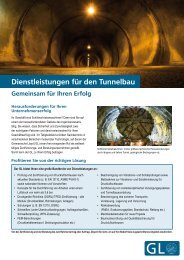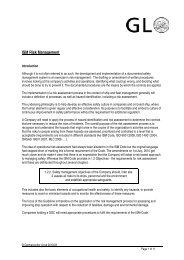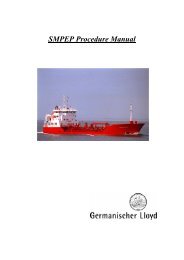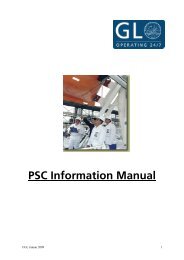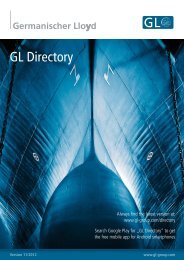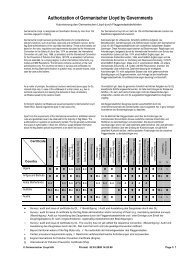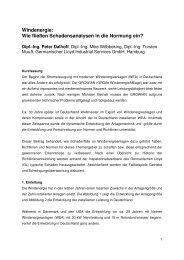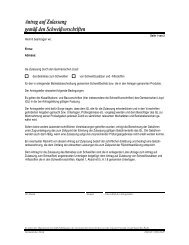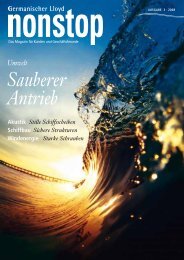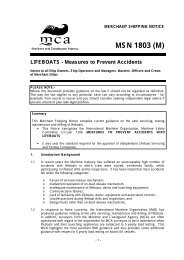Yards Moving Forward - GL Group
Yards Moving Forward - GL Group
Yards Moving Forward - GL Group
Create successful ePaper yourself
Turn your PDF publications into a flip-book with our unique Google optimized e-Paper software.
Dr. Manfred Feyer is in charge<br />
of the new testing laboratory<br />
in Hamburg-Harburg<br />
ter,” says Manfred Feyer. What it always boils down to is assisting<br />
the customer from a financial point of view, because the<br />
services provided by <strong>GL</strong>P help to prevent damage, clarify<br />
responsibilities, and optimize designs as well as production<br />
processes. To put it in a nutshell: cutting costs is the name of<br />
the game.<br />
Calling in the Specialists<br />
“We are<br />
something<br />
like technical<br />
pathologists”<br />
Feyer has a good example from his own professional experience:<br />
a cylinder-head bolt from the 1500 kW main engine<br />
of a container ship. Made of tempered chrome-molybdenum<br />
steel and with a length of 550 mm, this high-performance<br />
component had fractured at the first turn of the thread, as was<br />
shown by an inspection during operation. This circumstance<br />
led to considerable time spent in the yard, and hence enormous<br />
expense. The aim of the testing order issued to <strong>GL</strong>P was<br />
to identify the reasons and responsibility for the damage.<br />
Such an investigation does not necessarily start with<br />
sophisticated techniques. Before a case of damage is given<br />
“intensive care” in the laboratory, Manfred Feyer first collects<br />
as much information as possible on the general conditions<br />
under which the damage arose. “How old is the engine? Were<br />
Make it to break it: the stress at which the samples rupture<br />
provides clues about the material used<br />
MODERN DAMAGE ANALYSIS<br />
there any irregularities in shipboard operation? Has this sort<br />
of damage ever been encountered previously? These facts<br />
could give us valuable pointers to a systematic error,” says<br />
Feyer. In this initial phase, <strong>GL</strong>P cooperates closely with<br />
“Damage & Repair”, the central <strong>GL</strong> department for damage<br />
and repair management, which is based at Head Office of <strong>GL</strong><br />
in Hamburg and boasts one of the largest damage databases<br />
in the world. “These colleagues are the specialists with operational<br />
know-how, which we at <strong>GL</strong>P as experts for laboratorybased<br />
failure analysis simply cannot have. When handling<br />
cases of damage from the world of ship operation technology,<br />
we work hand in glove,” says Feyer.<br />
No Isolated Event<br />
Back to our cylinder-head bolt: here a check of the operational<br />
conditions turned up no abnormalities. But now the<br />
formidable analysis tools of <strong>GL</strong>P were brought to bear on the<br />
problem. The macroscopic study of the break yielded the first<br />
important finding: this was a fatigue fracture, starting from a<br />
crack in the root of the first thread turn. In contrast to a forced<br />
rupture, a fatigue fracture is not an isolated event that makes<br />
the part fail suddenly. On the contrary, a fatigue fracture<br />
develops through crack propagation over a lengthy period of<br />
time. Eventually, there is of course a final forced rupture and<br />
the total failure of the component. “In most cases, a fatigue<br />
fracture can be seen with the naked eye or by means of a magnifying<br />
glass,” Feyer explains. “The ruptured surface exhibits<br />
the lines of rest, or clamshell marks, which are typical of<br />
fatigue fractures.” The lines of rest of a fatigue fracture surface<br />
provide information about the growth of the crack. Or, to be<br />
more precise: the “times of rest” in which the crack only grows<br />
slowly or not at all – for example, because of machine downtime<br />
or a change in operating conditions.<br />
The first diagnosis was therefore fatigue fracture.<br />
However, such damage can normally be excluded if the specified<br />
material is used, if the installation and operation was as<br />
required, and if the necessary maintenance was carried out<br />
properly. So what had happened?<br />
nonstop 3/2006 61





